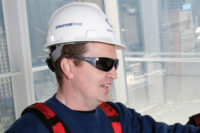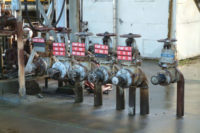
If you think the recently updated NFPA 70E, Standard for Electrical Safety in the Workplace, 2004 Edition, applies only to fire service personnel, think again. The standard is much more encompassing than that, applying to all employees who work on or near electrical equipment. Since virtually every industrial workplace houses electrical equipment in some way, shape or form, it is imperative to know how this document applies to your work situation and what personal protective equipment (PPE) is required to protect your workers.
“The standard discusses how to work safely around electricity,†says Hugh Hoagland, an electric arc consultant with ArcWear.com and a member of the International Safety Equipment Association (ISEA). “It affects a whole gamut of industrial workers, right down to maintenance workers.â€
Arc-flash PPE
Published in April of this year, the new NFPA 70E helps safety personnel with regard to their protective clothing efforts by including requirements for identifying existing hazards, what PPE is required, what safe work procedures are needed, and emergency/evacuation procedures.According to the American Industrial Hygiene Association (AIHA) Protective Clothing and Equipment Committee, while the National Fire Protection Association (NFPA) issues many fire service-related standards, they are also the stewards of the National Electrical Code (NEC) and many other electrical safety standards, such as NFPA 70E. The NEC spells out the recommended installation guidelines for electrical equipment, while NFPA 70E is a companion guide that gives safe work practices.
Originally issued in 2000, NFPA 70E is the first standard to specifically include arc-flash PPE in work practice requirements. In the new version, several changes have been made that give workers more flexibility in what protective clothing they can wear, notes Jeff Behar, chair of AIHA’s Protective Clothing and Equipment Committee. For instance, fabric weight restrictions have been modified to allow for newer, lighter weight flame-resistant clothing products that now typically weigh less than previously available fabrics. Also, flash suits and their face shields must now have adequate thermal rating. Face shields were not specifically called out in the previous edition of the standard.
Head to toe
“The 2000 edition [of NFPA 70E] and subsequent 2004 revision really is the first standard to address head-to-toe protection against electrical arc flash,†says Behar. “The hazard of shock has been known and dealt with for many years, but arc flash has only really been characterized and understood in the past ten years.“NFPA 70E is also one of the first safety standards that defines the magnitude of a hazard and matches the appropriate PPE. Other standards previously have either not addressed the arc-flash hazard or have given a ‘one-size-fits-all’ type of protective recommendation,†says Behar.
“This standard gives a user the tools to determine the hazards within their installation and put in place the appropriate PPE to help protect the workers,†adds Josh Moody, AIHA Protective Clothing and Equipment Committee member. “Not only is clothing covered by NFPA 70E, but gloves, footwear, head and eye protection, and even tools and equipment are addressed.â€
The standard applies to more than just electricians, Behar warns. It covers any person working on or near energized parts. “The scope of an existing electrical safety program must grow to encompass even those operators who throw a disconnect switch to start or stop their equipment,†he says.
Flash hazard analysis
The major theme of the PPE section within NFPA 70E is the flash hazard analysis, according to AIHA. A flash hazard analysis is now required to be performed before any person approaches the Flash Protection Boundary. The standard provides three routes to accomplish this:
Simplify your decision
Get to know NFPA 70E. It’s a standard that will simplify your decision-making process regarding what your workers should wear in most electrical hazard environments.SIDEBAR: The OSHA connection
The NFPA 70E standard was originally developed in 1979 as a guide for safe work practices for OSHA that would be compatible with the National Electric Code. OSHA does not “per se†enforce NFPA 70E; the agency uses it as a guideline.OSHA can, and has, required compliance to NFPA 70E when unsafe electrical practices are discovered at worksites. OSHA does enforce the NEC, and the 2002 version references NFPA 70E and requires marking of new equipment installation that has an electrical arc potential (Section 110.16).
For the revised 2004 version of NFPA 70E, OSHA provided consultation to the standard development to ensure compliance with current OSHA codes.
Source: AIHA Protective Clothing and Equipment Committee

